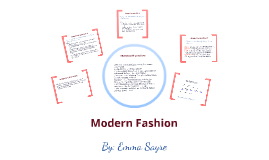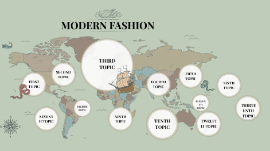Modern Fashion
Transcript: MODERN FASHION FIRST TOPIC THE TAMING OF THE SHREW The Taming of the Shrew is a comedy by William Shakespeare, believed to have been written between 1590 and 1592. The play begins with a framing device, often referred to as the induction, in which a mischievous nobleman tricks a drunken tinker named Christopher Sly into believing he is actually a nobleman himself. SECOND TOPIC GRUMIO Petruchio’s servant and the fool of the play—a source of much comic relief. PETRUCHIO Petruchio is a gentleman from Verona. Loud, boisterous, eccentric, quick-witted, and frequently drunk, he has come to Padua “to wive and thrive.” He wishes for nothing more than a woman with an enormous dowry, and he finds Kate to be the perfect fit. BAPTISTA MINOLA Minola Baptista is one of the wealthiest men in Padua, and his daughters become the prey of many suitors due to the substantial dowries he can offer. He is good-natured, if a bit superficial. BIANCA The younger daughter of Baptista. The lovely Bianca proves herself the opposite of her sister, Kate, at the beginning of the play: she is soft-spoken, sweet, and unassuming. LUCENTIO A young student from Pisa, the good-natured and intrepid Lucentio comes to Padua to study at the city’s renowned university, but he is immediately sidetracked when he falls in love with Bianca at first sight. CHARACTER INTRODUCTION: TRANIO BIONDELLO KATHERINE HORTENSIO GREMIO VINCENTIO Lucentio’s servant. Tranio accompanies Lucentio from Pisa. Wry and comical, he plays an important part in his master’s charade—he assumes Lucentio’s identity and bargains with Baptista for Bianca’s hand. Lucentio’s second servant, who assists his master and Tranio in carrying out their plot. The daughter of Baptista Minola, with whom she lives in Padua. She is sharp-tongued, quick-tempered, and prone to violence. Hortensio directs Petruchio to Kate and then dresses up as a music instructor to court Bianca. Hortensio ends up marrying a widow. Was rivals with Hortensio. Thwarted in efforts by Lucentio Lucentio's wealthy father from Pisa. THIRD TOPIC GRUMIO I think these servant/poor people's clothes is suitable for Grumio. The main reason is because, well, he is Petruchio’s servant. Another reason is because I think these Korean servant/poor people's clothes show the ‘poorness’ better than Italian servants’ clothes. Italian servant clothes still have color, looks decent and neat, and also looks like clothes for everyday wear. On the other hand, Korean servants’ clothes are made of a plain, dull-colored cloth, and doesn’t have fancy patterns. Double click to edit Click to see outfit FOURTH TOPIC PETRUCHIO I think that these tradtional Korean clothes would suit Petruchio. Based on Petruchio’s description in the book, he was a gentleman. I think the no-ri-gae [노리개(no-ri-gae): the traditional Korean accessory that you hang on the inside of the belt] and sat-gat [삿갓(sat-gat): traditional Korean hat for men only) helps the outfit look sophisticated. Although the description says that Petruchio was wealthy (and in stories, wealthy people usually wear extremely fancy clothes), I think he would be the type to wear simple-looking clothes. Left: traditional Korean men's Hanbok Middle: no-ri-gae Right: Sat-gat Click to see outfit I can imagine Baptista Minola as this smiling old man. Since he is wealthy, I thought it would be appropriate for his Hanbok to have a little bit of fancy embroidery on the belt. I think the brown color of the Hanbok gives off a soft and fatherly vibe. Also, I think that brown (don’t get me wrong, I absolutely love brown) is a color that not a lot of young people wear, so I thought that it would be nice if Baptista wore brown. BAPTISTA MINOLA FIFTH TOPIC Click to see outfit In the book, Bianca is soft-spoken, sweet and unassuming, as well as beautiful. I actually found two pictures of the Hanbok that reminded me of Bianca. The one on the left reminds me of Bianca’s wealth. The color pink and white make the Hanbok look like it was made for mature young women, and the gold details add in to make the Hanbok pretty, maybe to show Bianca’s beauty. The skirt of the Hanbok on the right, is ombre in the shade of purple. The color purple represents royalty, the details are less noticeable, and the skirt looks matte, so I think those qualities make the outfit look sophisticated, which suits Bianca. BIANCA SIXTH TOPIC Click to see outfits Hortensio is a gentleman of Padua who dresses up as a musical instructor to teach Bianca music. Because he dressed up as a music instructor, I believe he would’ve carried around an instrument around with him. I chose the Hanbok below because of two things. First, the sleeves of the Hanbok are different from other normal Hanboks; the sleeves are tight around the wrist so that it’s not distracting when playing the instrument. The second reason is that the color of his Hanbok isn’t bright but a dull, light brown color, similar to the traditional Korean instrument, geomungo [거문고 (geo-mun-go):

















